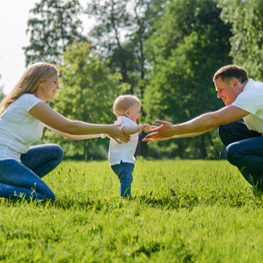
I often hear parents ask, “When should my baby start walking?” To begin with, “should” is a word that we should outlaw when it comes to babies! The important milestones in a baby’s life - such as walking and talking - occur at completely different times for each baby. Independent walking, like many other milestones, has a wide range of normal.
Some babies begin to walk at 10 months, and others wait until they are 18 months old or sometimes, even longer - and it’s all perfectly normal. How and when your baby begins his walking career has nothing whatsoever to do with future motor skills!
Walking and physical development
What’s most important in regard to your baby’s physical development is a gradual forward progression of skills. Watch your baby’s emerging skills and keep track of these.
While babies have their own unique ways of approaching the physical milestones that lead to walking (and some are known to skip some steps completely), this is the common process of progression of physical development from birth to walking:
Holds up head
Lifts head, shoulders and upper body when lying on tummy
Rolls over
Sits with support
Sits unsupported
Moves self around on the floor (rolling, squirming, scooting)
Stands when supported
Crawls, or finds some other method of moving from place to place
Pulls up to a stand
Cruises by holding on to furniture
Walks with hand-holding support
Walks independently
Runs
Why do babies walk when they do?
A baby who is a proficient crawler may be so satisfied with his ability to get around that he doesn’t even try to walk. A content and quiet baby may be much more interested in developing his small motor skills than walking. A chatterbox may be expending so much energy talking that there isn’t any left for walking. A happy in-arms baby may so enjoy being toted around by family members that he’s in no rush to get on the floor and go. These are just a few of the possible reasons a baby may wait until he’s a little older to begin walking.
There is just as much speculation about the early walker, too, such as a desire to keep up with siblings, or an eager energetic personality. For every theory as to why babies walk when they do, though, there’s a gaggle of babies who defy it!
How can I encourage my baby to walk?
The best device for encouraging a baby’s physical development is a big, empty floor in a safe room, and lots of free time to explore. Research shows babies do best in bare feet, since they use all of their muscles for grip and balance. (When it’s time to head outside, that’s when to put on some shoes.) You also can encourage your baby’s natural inclination to get up and move by having stable pieces of furniture or a sturdy, safe baby walker available for him to pull himself up on. Beyond this, cheer your baby’s attempts at walking and just let nature take its course.
What about swings, bouncers and jumpers?
There’s not doubt about it: Many babies love their swings, bouncers and jumpers. These can keep a baby entertained and happy while a parent makes dinner or catches up on paperwork. Keep in mind, though, these do not enhance development or encourage walking. An excess of time in these toys (and in infant seats and strollers) can actually delay physical development. The key is to use these devices for what they are: pure entertainment for your baby and a safe place for him when he’s not in your arms or rolling around on the floor.
When to be concerned
You know your baby better than anyone else. Closely monitor his development to see that he’s making steady progress along whatever path he’s on. Your health care provider will be tracking your baby’s development during regular exams. Your scheduled well baby visits are routine exams that have several purposes, one of which is to evaluate physical development. If you feel that your baby isn’t following a regular, sequential progression of development, talk this over with your health care provider at your next visit, or even before. This can help you find and address any problems early.
Elizabeth is a mother of four, and author of the bestselling No-Cry Solution series on topics such as sleep, discipline, picky eating and potty training. She is known worldwide as the voice of practical, respectful parenting. Visit her blog at elizabethpantley.com. Excerpted with permission by McGraw-Hill Publishing from The No-Cry Separation Anxiety Solution (McGraw-Hill) by Elizabeth Pantley.
Calgary’s Child Magazine © 2024 Calgary’s Child